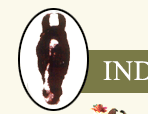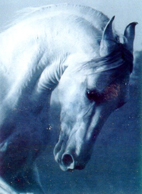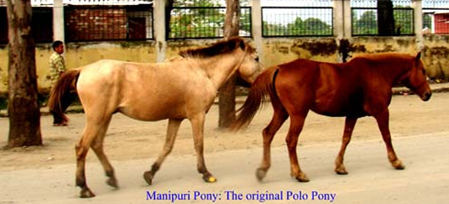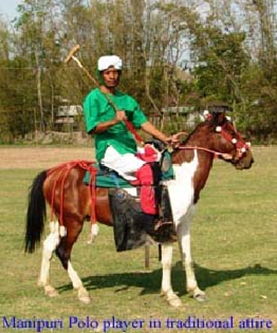


|
The
Horse Breed Standards
Characteristics of Manipuri Pony
Manipuri pony is the descendants of Asian wild horse. As such, the pony breeders of Manipur rear this animal in semi-wild system till today. The owner of pony after utilizing the animal sets the pony free to the vast green field for grazing purpose. Again when they need to utilize the animal, the owner use to drive his pony from the field to the stable and maintain them for 2 – 3 days to be used for various purposes e.g., transportation, polo games, Lai Haraoba, warfare etc. and sets free afterwards. While the ponies are kept in the stable, they are fed with indigenous grasses as well as concentrate feeds like rice brand, pulses etc. The ponies which are set free in the grazing field are found healthier than the ponies kept confined in the stable. Till today, Manipuri Ponies are living in the wild most of their life. They spent a little time in the stable. Genetically, Manipuri breed has no link with the Arabian Horses. In fact, Manipuri pony (one of the five recognized Indian Breeds) with a height between 11 to 13 hand high (1 hand = 4 inches approx.), short back, good shoulder, deep girth and well developed hind quarters is sure footed and sturdy. In general appearance, the Manipuri pony is typical of Asiatic variety of ponies which are widespread as far as Burma, South-Western parts of China, Thailand, Malaysia, Indonesia (Sumatra and Java). Thus, it is proved that the Manipuri pony is the descendants of Asian wild horse. In fact, it is a unique animal which is an inhabitant of the Indo-Burma region mega bio-diversity hot-spot of the world and has been in existence since pre-historic era. Head: Eye: Ears: Neck: Wither: Shoulder: Leg: Mane: Back and loin: Hindquarters: Tail:
Skin: Mammary Gland: Body Colour: Body size:
Source: Article published in the Souvenir brought out in connection with 2nd Manipuri Pony Show, 1997, organised by the Directorate of Veterinary and A.H. Services, Govt. of Manipur under the sponsorship of Dept. of A.H. and Dairying, Ministry of Agriculture, Govt. of India, written by Dr. H. Babu Singh. The Manipuri Pony In the dawn of history. when the entire south-east Asia was passing through a turbulent phase of nation building and massive human migration, bands of mounted warriors with quiverful of Arambai darts frequented the thick jungle of tropical Asia in their fervent search for a national identity. Criss-crossing between the twin rivers of Chindwin in the east in Myanmar and Surma in the west in Cachar (Assam), the sway of these Meitei warriors followed the cloud of dust kicked up by the galloping hooves of these mysterious ponies. The famous sword marks on the door of Kaunghmudaw Pagoda of Burma, during the sack of Sagaing by Gharib Newaz in 1738, was as much a tribute to the potential of these legendary Ponies as to the prowess of their owners. Later, they became well known as the Manipuri Pony- famous as the original polo pony when the game was first introduced to the European tea planters in Assam in the middle of Nineteenth century. The Manipuri pony has become an inseparable part of the history of the erstwhile kingdom of Manipur. During the time of Gharibnewaz (1714-54), it formed the backbone of his formidable cavalry. Under him "its expert horseman became the terror of upper Burma." In the early 19th century Manipur pony was again in the limelight when it sealed the fate of Cachari kingdom. Prince Marjit fled to Cachar after his unsuccessful tussle with his brother Chourjit for the throne of Manipur. "Marjit in his flight took with him a celebrated pony, which the Kachar Raja's brother, Govind Chandra, coveting, attempted to induce Marjit to part with it. Failing in this, he forcibly seized it . . . Marjit never forgave him." -writes R. Brown in his Statistical Account of Manipur. It was a forgone conclusion when, after a few years, Raja Govind Chandra was found murdered, his territory annexed by the British under the Doctrine of Lapse and Jiri, a part of the Cachari Kingdom permanently ceded to Manipur. Was Jiri, a price Govind Chandra paid posthumously for snatching the little pony which was dear to the heart of a Manipuri prince? What a price of a Pony! Spread over the ages, several gene pools might have been mixed up to give birth to the Manipuri Pony of present form and spirit. From the time of Kyamba (1467-1508) onwards, the Shan and other indigenous horses of Burma were often imported as war booty. Frequent raid of Gharibnewas in the territory of Burma always resulted in collection of large number of animals including horses. Cheitharol Kumbaba records the arrival of a number of Mangalsa (Mongol Horses) during the time of the same king. At one time a trader even bartered one Mongol horse for ten local Ponies. As reported by E.W.Dun in his Gazetteer of Manipur, there was a tentative experiment in crossing the Manipuri Pony with Arabian Horses. In 1859, at the request of Nara Singh, the regent of Manipur, the British Government in India sent an Arab Stallion and 8 mares to Manipur. Though reportedly the experiment ended in failure, it was possible that some genetic traits crossed over to the indigenous stock. However, trickling in of Arabian blood continued. Even a cart pulled by a Karuba (black horse) was presented to Maharaj Nar Singh by the British in 1847. As late as 1920s Maharaj Churachand owned a few Arabian horses. After the coming of age of the sport loving prince Churachand in 1907, a new chapter in the field of sport was opened in the state. Five days' continuous celebration of Maharajah's coronation with Sagol Kangjei (Polo), Mukna (indegenous wrestling) and Khong Kangjei (indigenous foot hockey) marked the beginning of a new era. Churachand Maharaj was the most sport-minded of all the kings ever ruled in this state. When he finally returned from Ajmeer after education in 1901, he brought two Arabian Horses with him. He was a very keen polo player. It was he who introduced modern equestrian sport in the state. Late Maibam Iboton Singh who was a reputed player during his time narrated the stories of newly introduced equestrian sports including Tep Chongba which is the local variation of British sport of SteepleChase. He also introduced certain changes in the rule of the local game of polo disallowing the practice of crossing the right of way of a player. He opened a new polo ground at his new Rajbari in 1922. Several brilliant polo players like Thourani Shabi, Eigya Shamjai, and Maibam Iboton flourished in his time. During the Second World War, a number of Austro-Whalers were brought into Manipur as pack ponies for the war effort through stud farms of the Army Remount Department. These horses were known as ATAR-WALLA by the local Manipuris. In sheer physical appearance, the Manipuri Pony is similar to its distant cousins like the Shan pony of Burma, Bataks and Sumba of Indonesia. All of them have the similar average height between 11 to 13 hands (1 hands = 4 inches). Among them the Manipuri Pony possesses a more developed and stronger quarters. It is very sturdy, compact and muscular with sort broad head and wide set eyes. The head is invariably wedge-shaped or ram-shaped. Occasionally, we see some slightly concave and dish faced ponies. As dished profile is generally considered a hallmark of the Arabian horses, we may presume the presence of some streaks of Arabian blood among the present Manipuri Ponies. The hooves of Manipuri Pony are closed and very strong. Hence, shoeing is unknown in Manipur. The Physical endurance of the Manipuri Pony is overwhelming and time tested. Normally, a horse at maximum level can play for two chukkers i.e. 14 minutes in a polo game. However, in Manipur a pony is hardly changed during the entire progress of a polo match - no matter how long the game continues. It is sheer testimony to the great endurance of these ponies. The tail of the local pony is highly set. It adds to the beauty of the breed. The Manipuri Pony or "Meitei Sagol" is one of the rarest breed of ponies of the world. The Government of India recognizes it as one of the 5 (five) indigenous breeds of horses/ponies of India. The Indian Council of Agricultural Research (ICAR) regards it as "ONE OF THE PUREST AND PRESTIGIOUS BREED OF EQUINES OF INDIA". It is the only recorded and living "ORIGINAL POLO PONY OF THE WORLD". When the British tea Planters discovered Polo in the plains of Cachar, while the game was being played by the fugitive Manipuri princes, they found the height of the ponies between 11 to 13 hands (1hand = 4 inches) at the withers. Thus, after the first Polo Club of the world was established at Cachar in 1859. The height of the polo pony, for a standard game, was restricted to 13 hands i.e. the standard height of the Manipuri Pony. The restriction of the height of the polo pony continued, though later relaxed up to 14 hands, till it was finally removed in 1916. During that period, the demand for Manipuri Pony was so heavy and the valley was so drained of ponies by its export that Sir James Johnstone, the then Political Agent of Manipur, had to ban the export of Manipuri pony till its number was increased to a viable level. He wrote "Manipur in old days possessed a famous breed of ponies, larger and better bred than the so called Burmese ponies that come from the Shan states. On these ponies were mounted the formidable cavalry that in the last century made Manipur feared throughout upper Burma, and enabled her rulers on more than one occasion, to carry their victorious arms within sight of Ava, where their Maharajah Pamheiba erected a stone pillar to commemorate the event". Practically, nothing is known regarding the pre-domestic period of Manipuri Pony except that in the Lai Haraoba, a local festival of deity worshipping, there is a mention of a Shamadom Ayangba (archaic name of Manipuri Pony) being captured for causing destruction to the Ingkhol (homestead) of one Konglouton Louthiba. This legend of flying horse Shamadon Ayangba being captured and domesticated after having its wings clipped is still kept alive by narration of local Meitei storytellers. Today, in the temple of Lord Marjing, believed to be the God of horses, at Heingang, one can still see a miniature statuette of Shamadon Ayangba, the legendary flying Manipuri Pony. The first mention of the breed in the written record is as late as 1584 AD when, during the period of Mungyamba a cursory mention of Shagon Cheneiye- meaning 'horse race conducted'- is found in Cheitharon Kumbaba (Royal chronicle). In the period before King Khagemba -boat, buffalo and elephant were dominantly used for transport both in war and peace. Frequent appearance of Shagol or Manipuri Pony in local literature starts from the time of the king Khagemba onwards. This period also witnessed the deepest involvement of horses and ponies in the history of human kind in all fronts - economic, political and social. The history of its utility and the mode of use affect the characteristics of a breed. Though in other parts of the world, horses were utilized for different purposed like ploughing, chariot pulling and other draught works - in Manipur they were never put to any other use except under the saddle either as an instrument of cavalry or transport or games like polo. The wheel was rarely used in Manipur long after its invention and utilization in other parts of the civilized world. Kangkhong or cartwheel is one of the Manipuri words connoting a wheel. Kangpot was a cart which was without a wheel and drawn mainly by the buffalo. It was the popular means of land transport. Hence the pony was hardly used for any other work except for riding with the saddle. Thus the basic characteristics of Manipuri pony like sure-footedness, strong and well proportioned quarters were developed under the pressure of carrying the weight of its rider at the back. Adoption of saddle ushered that long series of horse-borne invasions by archers in Asia and Europe- a tide that did not recede until the end of the 17th Century. The formidable Arambai(dart)-wielding Meitei cavalry that traversed along the river valleys of Chindwin in Burma and Barak in Assam vindicated the innate qualities of these small but tough ponies. Though the breed is referred and mentioned here and there in most of the equine related encyclopedias and other international publications, no thorough study of the breed has so far been conducted. In equine parlance, a breed is the one having a breed-society. The Manipuri pony is one of the few unfortunate breeds having no breed society of its own. It is high time that we have a breed society to identify, select, protect and preserve this ancient breed. The breeding can be started with the open registration of a foundation stock with the ponies meeting the prescribed bench mark of the society followed by the closed registration of the progenies of the foundation stock. The concept of a "pure-breed" is a relative term and the Manipuri breed in its purest form could have existed only in its wild ancestral herd- millions of years ago. The ancestry of modern horses is traced from four main lines of primitive horses that survived the Ice Age. They are Forest horse, a heavily built, solid type which lived in Northern Europe; the Plateau horse, that originated in Siberia, Northern Asia and Europe, the Tundra, which has virtually no influence on any of the present breeds except the Yakut horse which lives in the polar regions, and the Steppe horse, a finer pony, light in build, which came from Asia and North Africa. The Steppe horses are considered to be the ancestor of the Oriental breeds including Manipuri Pony. The study of the horses and its pedigree is one of the most advanced sciences of Paleontology. The scientific basis for the great Evolutionary Theory of Darwin was based on the study of the Equine Eohippus, known as Dawn Horse and its fossil remains. However, in the geographical extent of Manipur not a single fossil piece of the Equine group can be traced. Hence, the study of the Manipuri Pony and its antiquity should not be limited within the geographical ambit of the present day boundary of Manipur. Similarly, the study of this breed should not be limited to the traditional experts of which there is no dearth; the academic staffs of veterinary schools abound in them. Beyond the realm of pure naturalists and zoologists to fully understand the history of a particular breed, the study requires a different set of qualifications - like some acquaintance with practical horsemanship, horse mastership, and ownership. Recently, the population of the Manipuri pony has gone down to a dangerously low level of below two thousand in number. It is a grim picture. In the last part of the 19th Century and beginning of the 20th century, the ponies were numerous. In February, 1882, one Chongthamcha Top Manjor led a Manipuri Polo team to Cachar with 150 ponies. In the days of yore, Manipur had a plenty of open fields and lakes which were reserved as grazing fields. The ponies had abundant space for growth. Even in the central Imphal area, several dried lakes like Lamphel, Takyel and Porompat were bountiful with healthy ponies. However, with the increasing pressure of urbanization with their habitation having been forfeited by the encroaching human hordes, the ponies are fighting the last ditch for their survival in the lanes and streets of the State. Now, the maimed and diseased ponies at the street corners are not only a pitiable sight but also a traffic and health hazard. It is pathetic to see these animals that once carried the victory flag of Manipur from the Brahmaputra valley of Ahom to the Chindwin valley of Ava, now standing in groups in the street corners - maimed and diseased, uncared and unloved. After all, they are our heritage animal, deserving the full attention of the nation. The survival of Manipuri pony is a sine qua non for the survival of Manipuri Polo. Now that the state government has declared polo as a State Game, it will be more befitting to declare Manipuri Pony as a Heritage Animal with a sanctuary of its own for habitation. It is high time that an adequate reserved area be created in the state for the habitation of the Manipuri Pony to ensure the survival and continuity of the famed indigenous animal. The civilized world is now looking forward to a harmonious live-and-let-live environment between men and animal. |
|||||||||||||||||||||||||||||||||||||||||||||||


 Ponies is very popular animal amongst the people of Manipur. Manipuri Pony has been bred in Manipur since time immemorial. Pony figures prominently in Manipuri mythology and the history of Manipur as well as ancient Manipuri literature made accounts of the role Manipuri pony and its intricate presence in the social life of the people of Manipur. The ancient manuscript “Ougri” recorded about Manipuri Pony that “After completion of creation of earth by Ashiba, his father, the almighty god Atiya Shidaba asked his brother Apanba to create human beings to own the earth. Apanba, who was also known as Konglouton Louthiba, in consultation with his wife Leinung Chakha Khongjombi started plantation of beans on earth. Asiba became jealous and created Shamaton Ayangba (First pony on earth) to destroy Apanba’s creation of Human Beings and their agricultural works. Apanba then fought with Shamaton Ayangba and his wife Leinung Chakha Khongjombi helped in his conquest. Later, he cut off the wings and mane and tamed the pony to be used by human beings”. Thus, for the first time, pony was domesticated in Manipur.
Ponies is very popular animal amongst the people of Manipur. Manipuri Pony has been bred in Manipur since time immemorial. Pony figures prominently in Manipuri mythology and the history of Manipur as well as ancient Manipuri literature made accounts of the role Manipuri pony and its intricate presence in the social life of the people of Manipur. The ancient manuscript “Ougri” recorded about Manipuri Pony that “After completion of creation of earth by Ashiba, his father, the almighty god Atiya Shidaba asked his brother Apanba to create human beings to own the earth. Apanba, who was also known as Konglouton Louthiba, in consultation with his wife Leinung Chakha Khongjombi started plantation of beans on earth. Asiba became jealous and created Shamaton Ayangba (First pony on earth) to destroy Apanba’s creation of Human Beings and their agricultural works. Apanba then fought with Shamaton Ayangba and his wife Leinung Chakha Khongjombi helped in his conquest. Later, he cut off the wings and mane and tamed the pony to be used by human beings”. Thus, for the first time, pony was domesticated in Manipur. Nostril:
Nostril: 